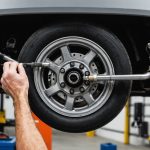Comfort on long rides is essential for enjoying your British touring motorcycle. One key aspect that often gets overlooked is rear suspension setup. Getting this right can significantly enhance your riding experience. With various factors influencing your bike's handling and comfort, understanding the intricacies of suspension will set you apart as a rider. This guide offers practical tips and insights to fine-tune your motorcycle’s rear suspension, ensuring effortless journeys through winding roads and open highways. Discover how to transform your rides into a smooth and pleasurable adventure.
Understanding Rear Suspension Systems
Motorcycle comfort heavily relies on the efficiency of its rear suspension system. The rear suspension is crucial in absorbing road shocks, maintaining stability, and ensuring a smooth ride. It consists of several components, including shock absorbers, springs, and linkages, each playing a vital role in the system's overall functionality.
In the same genre : Boosting Visibility for Classic UK Vehicle Drivers in Fog: Essential Tips and Techniques
There are different types of rear suspension systems, and understanding their differences is essential for riders seeking optimal performance. The monoshock system, for instance, uses a single shock absorber and is known for its streamlined design and superior handling. In contrast, the twin-shock system employs two shocks, offering a more traditional setup that some riders prefer for its classic feel and ease of maintenance.
Choosing the right rear suspension can significantly enhance motorcycle comfort, especially during long-distance rides. A well-designed suspension system not only cushions the rider from road irregularities but also improves traction and cornering stability. For touring enthusiasts, investing in a quality rear suspension system can make a noticeable difference in reducing rider fatigue and enhancing overall riding pleasure.
Also to read : Top Strategies to Cut Carbon Emissions in Classic UK Vehicles: A Path to Eco-Friendly Driving
Understanding these components and their impact on motorcycle dynamics is crucial for anyone looking to improve their riding experience. Whether for daily commutes or long adventures, the right suspension setup is key to achieving the desired comfort and performance.
Adjusting Rear Suspension Settings
Achieving the perfect suspension adjustment can greatly enhance your riding experience by optimizing comfort and performance. Understanding the right setup techniques is crucial for tailoring your motorcycle's rear suspension to suit your needs.
Pre-Ride Adjustments
Before hitting the road, it's essential to fine-tune your suspension settings. Preload, compression, and rebound damping are key factors to consider. Recommended settings often vary based on rider weight and luggage. For instance, increasing preload can help accommodate additional weight, while adjusting compression and rebound damping can ensure a smoother ride. Begin your initial setup by considering the riding conditions you expect to encounter, such as city streets or rugged trails.
Fine-Tuning for Comfort
Once on the road, fine-tuning becomes vital. Techniques for adjusting settings can significantly impact comfort, especially when adapting to personal riding styles. Periodic adjustments during long rides are important to maintain comfort levels. Listening to feedback from your bike can guide you in making incremental changes. If you notice harshness or instability, slight tweaks in the suspension settings can make a world of difference. Remember, the goal is to achieve a balance that complements your unique riding style and the varying conditions you face.
Troubleshooting Common Suspension Issues
Understanding and identifying suspension problems are crucial for maintaining motorcycle comfort and performance. Recognising the signs early can prevent more severe issues later.
Identifying Signs of Suspension Issues
Common indicators of suspension issues include excessive bouncing, bottoming out, and unusual noises. If your motorcycle feels unstable or you notice a decrease in handling precision, it might be time to inspect your suspension system. Bouncing often signifies inadequate damping, while bottoming out suggests insufficient preload or worn components.
Common Problems and Their Causes
Several common suspension problems can affect your ride. Leaking oil from the shock absorbers is a frequent issue, typically caused by worn seals. This can lead to reduced damping efficiency. Another problem is worn components, such as bushings or springs, which may result in a sagging suspension and decreased responsiveness.
Solutions and Maintenance Tips
To address these issues, follow a systematic troubleshooting guide. Regularly inspect your suspension for leaks and check for worn parts. Replacing seals and components as needed can prevent further damage. Additionally, maintaining the correct suspension settings and performing routine maintenance can significantly extend the life of your system. Implementing these maintenance tips ensures your motorcycle remains in optimal condition, enhancing both safety and comfort.
Comparing Suspension Types and Brands
When choosing a motorcycle's rear suspension, understanding the differences between brands and types is essential for achieving optimal performance. Suspension Comparison involves evaluating popular brands like Öhlins, Showa, and KYB, each offering unique features tailored to specific riding needs. For instance, Öhlins is renowned for its precision engineering and high-end performance, making it a favourite among racers and enthusiasts seeking superior handling.
In a detailed Performance Analysis, monoshock systems often outperform twin-shock setups in terms of agility and responsiveness. However, twin-shock systems are preferred by some for their classic feel and ease of maintenance. Riders frequently report that Öhlins monoshocks provide exceptional stability and control on challenging terrains, while Showa's twin-shock systems are praised for their durability and comfort during long rides.
Brand Reviews highlight that KYB offers a balanced approach, delivering reliable performance at a competitive price. Rider testimonials often mention KYB as a go-to for those seeking a cost-effective solution without compromising on quality. Experiences vary, but many riders appreciate the adaptability and consistent performance across different conditions. Understanding these differences can guide you in selecting the right suspension setup to enhance your motorcycle's comfort and performance.
Maintenance for Longevity and Performance
Consistent suspension maintenance is key to ensuring your motorcycle's rear suspension remains in prime condition. Regular inspections and servicing are crucial for identifying wear and tear early, preventing more significant issues from arising.
Routine Maintenance Tasks
To maintain optimal performance, focus on routine tasks such as cleaning and lubricating suspension components. Dirt and grime can accumulate, leading to increased friction and wear. Regularly check for any signs of damage or leaks in the shock absorbers and springs, as these can significantly impact ride comfort.
Importance of Regular Inspections
Conducting regular inspections allows you to spot potential problems before they escalate. Look for signs of suspension wear, such as sagging or uneven handling. If you notice any unusual noises or changes in ride quality, it may be time for a professional check-up.
Tips for Prolonging Suspension Life
To extend the life of your suspension components, follow these care tips:
- Adjust settings according to your riding conditions and load.
- Ensure all bolts and fastenings are secure.
- Use high-quality parts for replacements to enhance performance enhancement.
By adhering to these guidelines, you can significantly improve your motorcycle's longevity and maintain a smooth, comfortable ride.
















